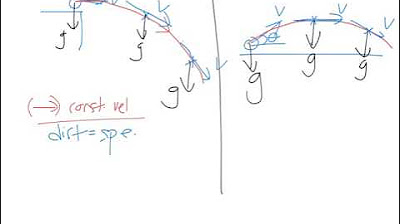Der waagerechte Wurf - tolles Experiment
Summary
TLDRThis video explains the principle of separating horizontal and vertical motion in mechanics, demonstrated through a simple experiment involving a tennis ball, a metal disk, and a small car. The experiment shows that both objects, regardless of their horizontal motion, fall at the same rate due to gravity. The script breaks down the physics behind projectile motion, highlighting how objects move in a parabolic trajectory. A simple home experiment with a ruler and coin further illustrates the same principle. The video aims to teach viewers how independent motion components work together in real-world scenarios.
Takeaways
- 😀 The video demonstrates how to break down movements into horizontal and vertical components.
- 😀 A tennis ball is used as an example to show simultaneous forward and downward motion.
- 😀 A light barrier triggers an electrical impulse that controls an electromagnet, holding a metal disc in place.
- 😀 When the light barrier is interrupted, the electromagnet releases the disc, causing it to fall.
- 😀 The disc and the car are initially at the same height, and both fall simultaneously after the light barrier is triggered.
- 😀 The car moves forward with a constant velocity (uniform motion) while the disc falls vertically due to gravity (accelerated motion).
- 😀 Both the car and the disc fall at the same rate due to gravity (9.81 m/s²), meeting at the same point in mid-air.
- 😀 The concept demonstrated shows that horizontal and vertical motions are independent of each other.
- 😀 The car's horizontal motion is uniform, while the disc's vertical motion is accelerated due to gravity.
- 😀 A simple home experiment with a ruler and a coin is used to demonstrate the same principles of decomposed motion.
Q & A
What is the main concept demonstrated in the experiment?
-The main concept demonstrated is the decomposition of motion into horizontal and vertical components, showing how both motions can happen independently but simultaneously.
How does the tennis ball behave in the experiment?
-The tennis ball moves both downward due to gravity and forward due to the force applied to it. Its motion follows a parabolic trajectory, which is a combination of uniform motion in the horizontal direction and accelerated motion in the vertical direction.
What role does the light barrier play in the experiment?
-The light barrier detects when the tennis ball crosses it and sends a signal to the electromagnetic switch, which triggers the release of the metal disk. This helps demonstrate the simultaneous nature of the ball's motion and the falling disk.
How does the electromagnetic switch work in the experiment?
-The electromagnetic switch is activated by a signal from the light barrier. When the switch is triggered, it closes the circuit, allowing current to flow and generating a magnetic field that holds the metal disk in place. Once the circuit is broken, the disk falls.
Why do the tennis ball and metal disk fall at the same rate?
-Both the tennis ball and the metal disk experience the same gravitational acceleration, meaning they fall at the same rate regardless of their horizontal motion. This demonstrates that vertical motion is independent of horizontal motion in projectile motion.
What is a parabolic trajectory?
-A parabolic trajectory is the curved path an object follows when it is launched with an initial velocity and affected by gravity. In the experiment, the tennis ball follows a parabolic path, combining horizontal motion with accelerated vertical motion.
How does the concept of constant velocity and accelerated motion relate to the experiment?
-In the experiment, the tennis ball moves horizontally at a constant velocity (due to the initial force) while simultaneously accelerating downward due to gravity. This demonstrates the combination of constant and accelerated motion in projectile trajectories.
What would happen if the tennis ball didn't reach the light barrier in time?
-If the tennis ball didn't reach the light barrier, the metal disk would not be released because the signal from the light barrier would not be sent to activate the electromagnetic switch. The experiment relies on the ball triggering the disk's fall.
What does the at-home experiment with the ruler and coin demonstrate?
-The at-home experiment demonstrates the same principle of simultaneous vertical and horizontal motion. When a ruler is quickly pulled off a table, the coin is pushed horizontally while simultaneously falling due to gravity, showing how both motions occur independently but at the same time.
Why do the ball and disk meet in mid-air despite different horizontal motions?
-The ball and disk meet in mid-air because they both experience the same gravitational acceleration and fall at the same rate vertically. The horizontal motion of the ball does not affect its vertical falling speed, so both objects land at the same time and place if released from the same height.
Outlines

This section is available to paid users only. Please upgrade to access this part.
Upgrade NowMindmap

This section is available to paid users only. Please upgrade to access this part.
Upgrade NowKeywords

This section is available to paid users only. Please upgrade to access this part.
Upgrade NowHighlights

This section is available to paid users only. Please upgrade to access this part.
Upgrade NowTranscripts

This section is available to paid users only. Please upgrade to access this part.
Upgrade Now5.0 / 5 (0 votes)





